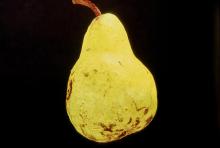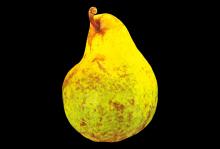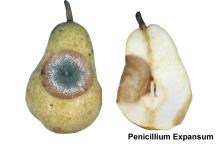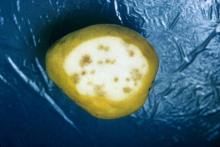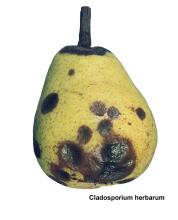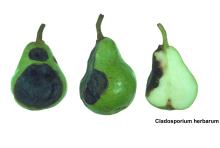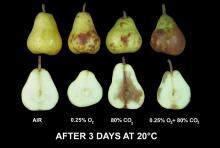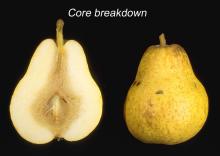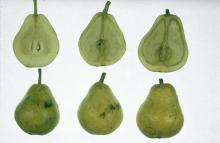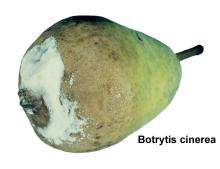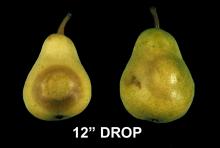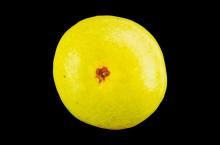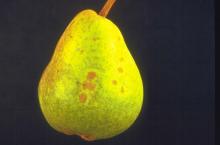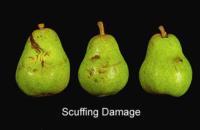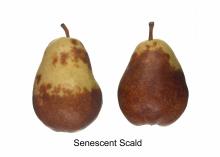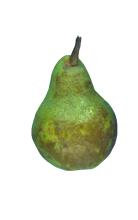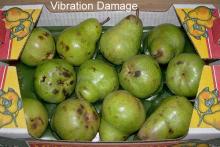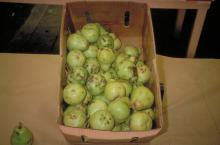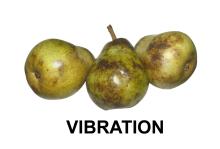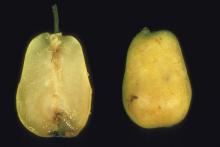Product Description
Índices de madurez
Las peras 'Bartlett' adquieren mejor calidad comestible si se les cosecha en el estado verde-maduro (madurez fisiológica) y posteriormente se les madura para su consumo, debido a que se vuelven harinosas cuando se les permite adquirir madurez de consumo en el árbol.
Las normas o estándares de madurez de las peras 'Bartlett' de California utilizan un índice combinado firmeza-contenido de sólidos solubles (CSS) que se modifica dependiendo del tamaño de la fruta y del color de su piel. Si la fruta esta en color verde amarillento, no hay límites de firmeza ni del CSS).
| CSS Mínimo | Firmeza Máxima de Pulpa (Libras-Fuerza)1 | |
| Diámetro de la Fruta 2 3/8" a 2 1/2" | Diámetro de la Fruta >2 1/2" | |
| <10% | 19.0 | 20.0 |
| 10% | 20.0 | 21.0 |
| 11% | 20.5 | 21.5 |
| 12% | 21.0 | 22.0 |
| 13% | [Sin límite] | [Sin límite] |
1 Fuerza de penetración con un punzón de 8 mm (5/16 pulgada).
- Forma de la fruta, tamaño y ausencia de daño por insectos, daños mecánicos (impacto, compresión y/o magulladuras por vibración), pudriciones y otros defectos
- Un sabor dulce, aroma agradable, textura jugosa y una consistencia similar a mantequilla son características deseables para el consumo de peras maduras (la firmeza de la pulpa varía entre 2 y 4 libras-fuerza)
Manejo y almacenamiento poscosecha
-1 a 0°C (30 a 32°F)
90 a 95%
| Temperatura | 0°C (32°F) | 2°C (36°F) | 5°C (41°F) | 20°C (68°F) |
| mL CO2/kg·h | 2-3 | 4-5 | 6-8 | 15-35 |
Para calcular el calor producido multiplique mL CO2/kg·h por 440 para obtener Btu/ton/día o por 122 para obtener kcal/ton métrica/día.
| Temperatura | -1 a 0°C (30 a 32°F) | 5°C (41°F) | 10°C (50°F) | 20°C (68°F) |
| µl C2H4/kg·hr | 0.1-0.5 | 2-4 | 5-15 | 20-100 |
Las peras 'Bartlett' recién cosechadas en estado verde-maduro pueden tratarse con etileno [100 ppm de etileno por 24 a 48 horas a 20-25°C (68 a 77°F)] para conseguir una maduración uniforme dentro de los 4-6 días posteriores al comienzo del tratamiento. A menudo, este tratamiento "en la cosecha" se conoce como "acondicionamiento" (conditioning). Las frutas que se han refrigerado por 3 semanas madurarán uniformemente sin el acondicionamiento con etileno. Estas peras también pueden madurarse en presencia de etileno (100 ppm) a 18-22°C (64-72°F).
AC óptima 1 a 3% O2 + 0 a 3% CO2; para las peras 'Bartlett' producidas en California, se recomienda 1.5 a 2% O2 + 1 a 5% CO2 para un almacenamiento de largo plazo de frutas de estación temprana y media. Para las peras de estación tardía, el CO2 debe mantenerse a menos del 1% debido a la mayor sensibilidad de estas frutas al daño por CO2(pardeamiento de la pulpa y del corazón).
Las condiciones de AC retrasan la tasa de respiración, la producción de etileno, el cambio de color del verde al amarillo y el ablandamiento de las peras. El desarrollo de escaldado y la incidencia de pudriciones también se ven disminuidas en AC.
El potencial de almacenamiento de las peras 'Bartlett' a temperaturas de -1 a 0°C (30 a 32°F) y 90-95% de HR puede ser tan larga como 3 meses en aire y 6 meses en AC.
Physiological and Physical Disorders
Escaldado (scald). El escaldado por senescencia es una fisiopatía de la piel que puede ocurrir durante el almacenamiento o la subsiguiente maduración. El tratamiento de las peras inmediatamente después de la cosecha, con un antioxidante tal como la etoxiquina (ethoxyquin) aplicada de acuerdo con las instrucciones indicadas en la etiqueta, puede reducir significativamente la incidencia del escaldado por senescencia. El uso de la etoxiquina no esta aprobado en California.
Degradación acuosa (watery breakdown). Las pérdidas por esta fisiopatía son debidas a un rápido deterioro enzimático de la pulpa (excesivo ablandamiento) que ocurre en ocasiones durante el almacenamiento, pero mayormente durante la subsequente maduración. Un enfriamiento inmediato y eficiente y el mantenimiento de temperaturas óptimas de -1 a 0°C (30 a 32°F) minimizará las pérdidas debidas a la degradación acuosa.
Cáliz rosa (pink calyx). La presencia de temperaturas frías durante el crecimiento pueden provocar el deterioro por esta fisiopatía y la maduración prematura de las peras 'Bartlett'.
Fisiopatías relacionadas con AC. La exposición de las peras a atmósferas de composición inadecuada (concentración de O2 inferior y/o de CO2 superior a las arriba indicadas como óptimas en el apartado de Efectos de las Atmósferas Controladas) pueden inducir fisiopatías y problemas de maduración cuando las frutas se remueven de las condiciones de AC. Estas peras muestran pardeamiento de la pulpa, cavidades en los tejidos dañados y fermentación que da lugar a la acumulación de acetaldehído, ethanol y acetato de etilo y al desarrollo de sabores desagradables.
Daño por abrasión. Los síntomas incluyen manchas o bandas pardas en la piel debidas a rodamiento, roce o vibración. Generalmente, no hay daño visible debajo de la superficie. Este problema puede minimizarse inmobilizando las peras (por ejemplo mediante un empacado compacto,"tight- fill packing") o colocándolas en bolsas de plástico dentro de los envases para la transportación.
Magulladuras por impacto. El color pardo de la pulpa es el resultado de las magulladuras por impacto; la severidad aumenta con la altura de la cual cae la fruta. Las peras parcialmente maduras y con madurez de consumo son más susceptibles al daño por impacto que las frutas en estado verde-maduro.
Desórdenes
Pudrición por moho azul (blue mold). Causada por Penicillium expansum, parásito que penetra por heridas por lo que rápidamente coloniza las áreas dañadas por cortaduras y picaduras en las peras. Evitar los daños físicos es la mejor medida para prevenir el ataque de este hongo.
Pudrición por moho gris (gray mold). Causada por Botrytis cinerea. La infección ocurre durante la floración y permanece latente hasta que las peras empiezan a madurar, momento en el cual el hongo puede crecer dentro de la fruta, especialmente en las áreas calicina y peduncular. Botrytis puede también entrar a la fruta a través de las heridas ocasionadas durante el manejo postcosecha. Las estrategias de control incluyen minimizar los daños mecánicos, inmediato enfriamiento y mantenimiento de la temperatura óptima durante el transporte y el almacenamiento.
References
En el futuro se añadirán referencias procedentes de fuentes científicamente validadas.







